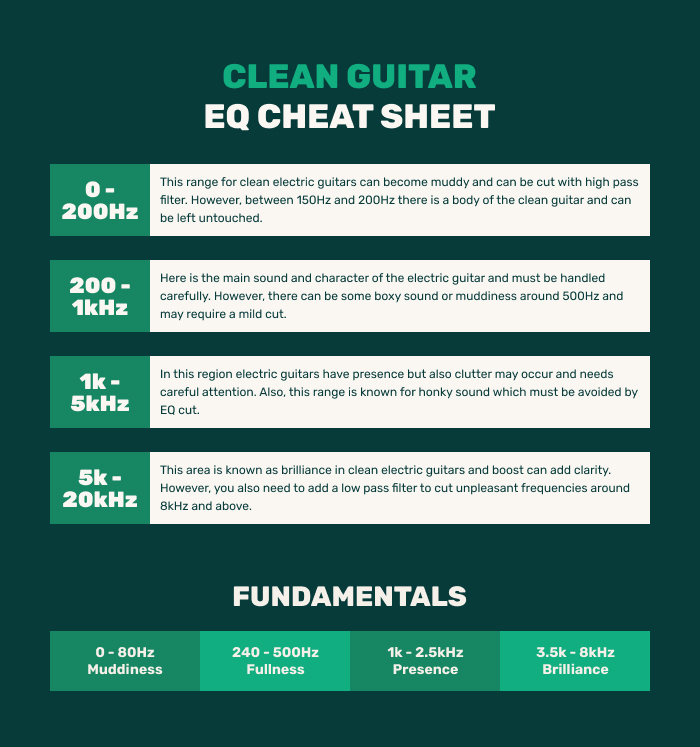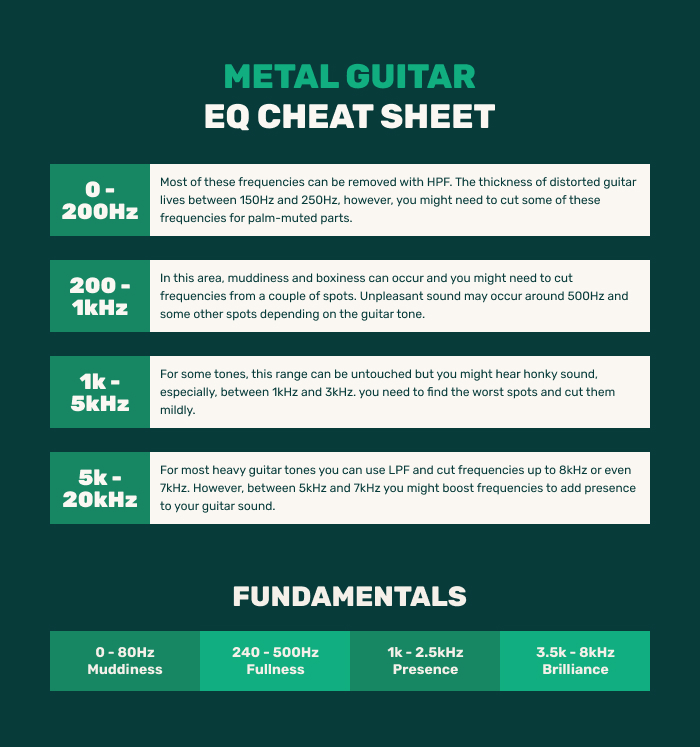In rock and metal music, mixing electric guitars correctly is one of the most important things.
So, it’s crucial to know which frequencies of electric guitars are good and which ones you should cut. And this concerns both – clean and distorted guitar tones.
Understanding the frequency range of the electric guitar is key to unlocking its full potential and achieving the desired tonal balance.
With EQ, you can boost or cut specific frequencies to create a clear and defined sound or add warmth and depth to your playing.
Electric Guitar Frequencies
In this guide, I’ll explore the frequency spots that are essential for getting the best out of your distorted and clean electric guitar sound during mixing. After that, you will mix electric guitars more confidently.
Clean Guitar EQ Cheat Sheet
- 0-200Hz – The frequency range of clean electric guitars has the potential to become muddled and can be addressed through the use of a high pass filter. However, the section between 150Hz and 200Hz represents the body of the clean guitar and is a range that can be left unaltered.
- 200-1000Hz – The primary tone and character when mixing clean electric guitars should be treated with care, but there may be some boxy or muddy sound around the 500Hz frequency range that could benefit from a slight reduction.
- 1000-5000Hz – This area of the frequency spectrum is where electric guitars can have a noticeable impact, but it can also be susceptible to unwanted clutter that requires close monitoring. Additionally, this range is notorious for producing a honky sound that must be eliminated by reducing its level through EQ.
- 5000-20000Hz – In the context of clean electric guitars, this particular frequency range is commonly referred to as “brilliance,” and increasing it through a boost can enhance the clarity of the sound. However, to avoid any unpleasant frequencies that may be present at 8kHz and higher, it’s important to apply a low pass filter to effectively cut them out.

Metal Guitar EQ Cheat Sheet
- 0-200Hz – A high-pass filter can eliminate many of these frequencies. Typically, the distorted guitar’s fullness lies within the range of 150Hz to 250Hz, although you may need to reduce some of these frequencies for sections that use palm muting.
- 200-1000Hz – Within this range, there is a possibility of sound distortion, where the audio may become muddy or boxy. It might be necessary to reduce the frequency levels in a few specific areas to address this issue. An unappealing sound can manifest around 500Hz and other areas that vary depending on the guitar’s tone.
- 1000-5000Hz – There are certain tones where you may not need to adjust this range, however, you may notice an unpleasant honky sound between 1kHz and 3kHz while mixing heavy electric guitar tracks. In this case, it is necessary to identify the problematic frequencies and apply a mild cut to achieve a more balanced sound.
- 5000-20000Hz – To achieve heavy guitar tones, it is common practice to employ LPF and attenuate frequencies ranging up to 8kHz, or in some cases, even 7kHz. Nevertheless, frequencies between 5kHz and 7kHz may be elevated to introduce more definition and prominence to the guitar’s sound. However, this might vary for different guitar tones.

Conclusion
Understanding the frequency range and using EQ correctly is critical for producing a balanced and full sound on electric guitars. You can enhance the unique tone and character of the instrument and create a distinct sound that suits your musical style by using EQ to boost or cut specific frequencies. It is critical to identify the frequency sweet spots and avoid frequencies that can make your guitar sound muddy or harsh.
